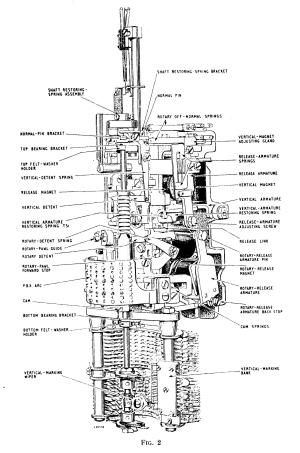My career started with a 3 year
apprenticeship with what was originally "The G.P.O.", quickly became
Post Office Telecommunications, and with the later privatisation of the
company it became better know as British Telecom.
The first year as an apprentice was to gain an overall understanding of
the company. This involved a few weeks in every department, and longer
periods in the main three areas of engineering work. These were;
1. "Subs App" - Subscribers apparatus (phones in homes and offices)
2. External - "up the poles and down the holes"
3. Internal - telephone exchange maintenance and construction.
During the second year the duties started to become more specific and
included more advanced external systems such as PABX's (Private
Automatic Branch Exchanges - telephone exchanges used internally by
large companies).
The third year was specialised to only the duties involved once
promoted from a T.T.A. (Trainee Technician Apprentice) to T2A
(Technician grade 2A).
My specialisation was in Telephone Exchange maintenance. In 1974 I was
promoted to a T2A and my first duties were New Line Provision. This
involved adding new wiring to connect new subscribers to the telephone
exchange, and completing the exchange records to show what was
connected to where. It also involved the reverse where lines were
disconnected. Other duties included testing of new, and existing lines
to determine fault locations, and to repair those faults.
2 years later.in 1976, I was further promoted to T.O. (Technical
Officer). As a T.O my duties were fault diagnosis, repair and
preventative maintenance on electro-mechanical (Strowger) telephone
switching equipment. Some of the equipment was over 40 years old (see
picture on left) and needed an extra delicate touch.
During those first 5 years I attended 7 internal training courses
lasting a total of 117 days, each being held in BT's own training
college. I also attended S.E. London Technical College for the City
& Guilds Telecomms technician course. By 1975 I had achieved the
Intermediate Certificate (Year 1 and 2) and all of year three. (In 1980
I sat the fourth year examinations but failed the Maths).
As time progressed more and more electronic equipment was being
introduced into the telephone exchange. I was an early candidate for a
40 day course on some almost "state of the art" equipment known as the
Register Translator 13. This used relatively new, low power Metal Oxide
Semiconductor medium scale integrated circuits. This was my first
introduction to working with double-sided plated through hole PCB
technology. Fault diagnosis and repair was expected to be down to
component level, and, for probably the first time, introduced an
oscilloscope to the exchange apparatus floor.
By 1990 the days of Strowger telephone exchanges were almost over. The
exchange I was working in was due for closure. It would be replaced by
a modern all digital exchange. My last 6 months at the old exchange
were spent as a temporary T.O.[A] (Technical Officer with allowance).
In ouside industry this would be equivalent to Senior Engineer, or
supervisor. I had in my supervision about 5 staff, but with the added
complication of also being onsite negotiator with building contractors
who were extending the building for the replacement telephone exchange.
After the strowger exchange had closed down I transferred to electronic
telephone exchanges. The type of exchange I worked on was known as a
TXE4A and the basic skills required for maintenance needed another 70
days of training courses. Once again these were also held at the BT
training school near Old Street in London. Once again repair was
expected down to component level. Fault diagnosis was often computer
aided, at a system wide level, but the final diagnosis needed manual
intervention with test meters and oscilloscope (now a 4 channel storage
beast).
In 1992, as a result of privatisation, BT started it's first major
staff shake up with a scheme called "Release 1992". This offered some
very generous voluntary redundancy terms. With the demise of the TXE4A
exchanges already on the horizon, to be replaced by fully digital
exchanges, I decided to take the redundancy package. It was a very
enjoyable 21 years, but the new exchanges would finally be unmanned and
maintenance would be done by mobile staff. With no driving licence, and
no real desire to get one, I thought it may be better to try my luck in
pastures new.
There are three, possibly significant, training courses that I attended that I have not mentioned yet. They were.
- First line maintenance for 30 channel PCM systems.
- First line building and power maintenance.
- ISO 9001 appreciation.
